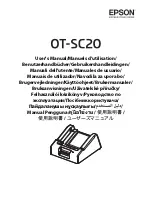
UMAX090690. Version: 1.2 Preliminary Documentation
– May Be Subject To Change
17-37
requested will the DTC go inactive. This feature may be useful in a system where a critical fault
needs to be clearly identified as having happened, even if the conditions that caused it went away.
In addition to all the active DTCs, another part of the DM1 message is the first byte, which reflects
the Lamp Status. Each Diagnostic function block has the setpoint
Lamp Set by Event in DM1
which determines which lamp will be set in this byte while the DTC is active. The J1939 standard
defines the lamps as
‘
Malfunction
’
,
‘
Red Stop
’
,
‘
Amber, Warning’
or
‘Protect’
. By default, the
‘Amber, Warning’
lamp is typically the one set by any active fault.
By default, every Diagnostic function block has associated with it a proprietary SPN. However, this
setpoint
SPN for Event used in DTC
is fully configurable by the user should they wish it to reflect
a standard SPN define in J1939-71 instead. If the SPN is change, the OC of the associate error log
is automatically reset to zero.
Every Diagnostic function block also has associated with it a default FMI. The only setpoint for the
user to change the FMI is
FMI for Event used in DTC
, even though some Diagnostic function
blocks can have both high and low errors. In those cases, the FMI in the setpoint reflects that of
the low-end condition, and the FMI used by the high fault will be determined per Table 4. If the FMI
is changed, the OC of the associate error log is automatically reset to zero.
FMI for Event used in DTC
– Low Fault Corresponding FMI used in DTC – High Fault
FMI=1, Data Valid But Below Normal
Operational Range
– Most Severe Level
FMI=0, Data Valid But Above Normal
Operational Range
– Most Severe Level
FMI=4, Voltage Below Normal, Or
Shorted To Low Source
FMI=3, Voltage Above Normal, Or Shorted To
High Source
FMI=5, Current Below Normal Or Open
Circuit
FMI=6, Current Above Normal Or Grounded
Circuit
FMI=17, Data Valid But Below Normal
Operating Range
– Least Severe Level
FMI=15, Data Valid But Above Normal
Operating Range
– Least Severe Level
FMI=18, Data Valid But Below Normal
Operating Range
– Moderately Severe
Level
FMI=16, Data Valid But Above Normal
Operating Range
– Moderately Severe Level
FMI=21, Data Drifted Low
FMI=20, Data Drifted High
Table 9
– Low Fault FMI versus High Fault FMI
If the FMI used is anything other than one of those in Table 4, then both the low and the
high faults will be assigned the same FMI. This condition should be avoided, as the log
will still use different OC for the two types of faults, even though they will be reported
the same in the DTC. It is the user’s responsibility to make sure this does not happen.
When the fault is linked to a DTC, a non-volatile log of the occurrence count (OC) is kept. As soon
as the controller detects a new (previously inactive) fault, it will start decrementing the
Delay
Before Sending DM1
timer for the Diagnostic function block. If the fault has remained present
during the delay time, then the controller will set the DTC to active, and it will increment the OC in
the log. A DM1 will immediately be generated that includes the new DTC. The timer is provided so
that intermittent faults do not overwhelm the network as the fault comes and goes, since a DM1
message would be sent every time the fault shows up or goes away.
















































